Preschool Design
Preschool Design Guidelines
Design Your Own Preschool Classroom
Preschool design should include the right furniture, play centers, activities spaces and other elements that are age appropriate and conducive to learning. It should also be designed with the needs of the children in mind, taking into account their size, mobility level, interests, and abilities. With careful planning and creative preschool exterior design ideas, preschool owner can create a preschool classroom that encourages exploration, discovery, and growth.
The preschool classroom design is to let children have better learning and growth of the place. Early childhood education does not depend on how much knowledge the child has learned, but rather cultivates interest in learning and develops good behavior habits. The preschool designs layouts goal of the preschool classroom is to assist teachers in educating children,because children in this age group are relatively weak in safety awareness and do not have a clear understanding of learning. The modern preschool interior design concept of child care centers should take into account a variety of factors, such as courses of study, children’s age, space planning, child care center culture, etc. Incorporating the above elements into the preschool interior design, the entire child care center will be more vigorous.
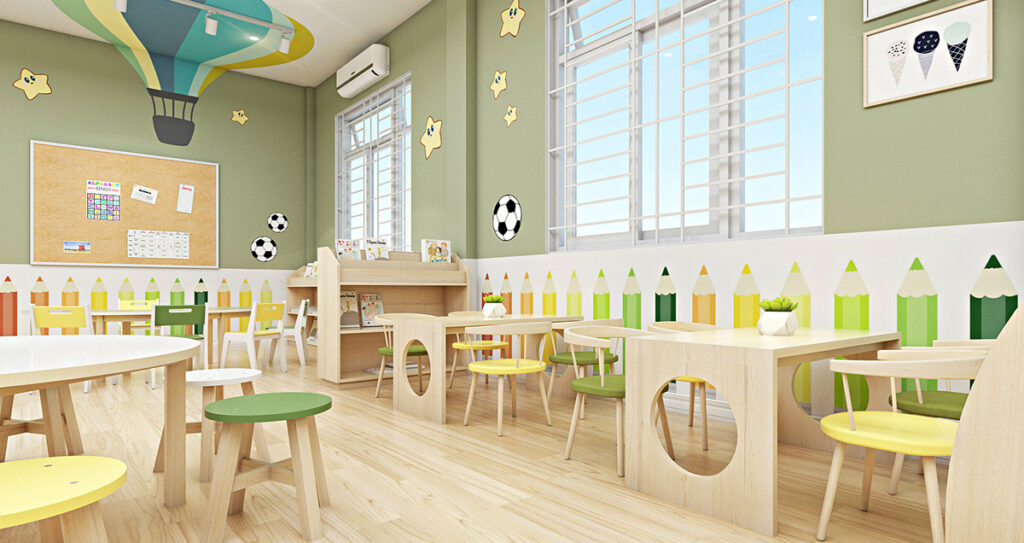
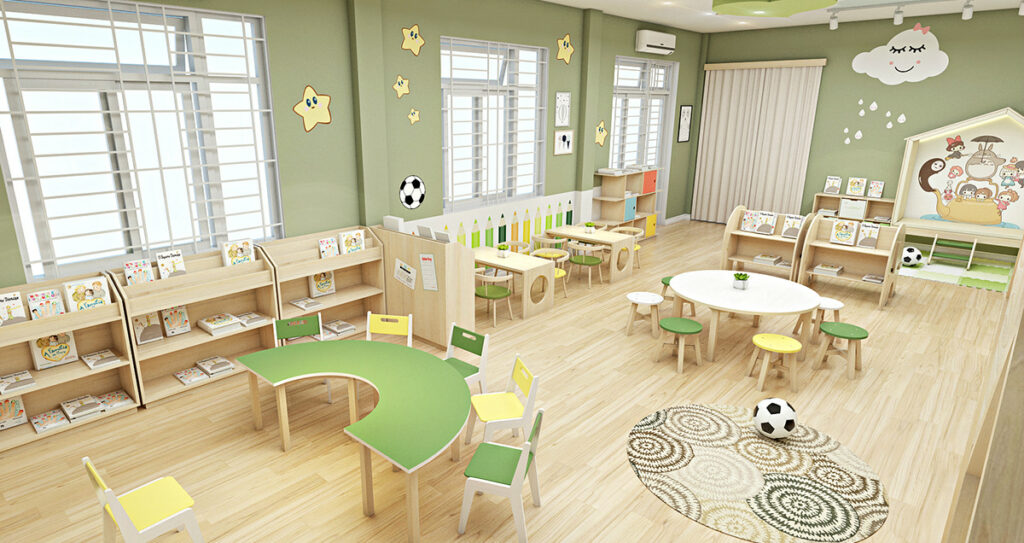
Design for preschool classroom is important for the learning environment. Preschool is a crucial time in a child’s development, and the design of their learning environment can play a significant role in shaping their growth and learning. From the preschool room layout to the materials and equipment used, thoughtful preschool room design can create a safe, stimulating, and engaging space for young children to explore and learn. In this article, we’ll explore the importance of preschool design requirements and offer tips for creating an effective learning environment.
When designing a preschool floor plan layout, there are several factors to consider. First and foremost, safety should be a top priority. The classroom design layout for preschool should ensure that children can move around freely without any obstacles or hazards. It should also provide clear pathways and easy access to essential areas such as bathrooms, storage spaces, and exits.
Innovative classroom design for preschool also takes into account age-appropriate materials and equipment placement. This includes low shelves for easy access to toys and supplies, child-sized furniture to promote independence, and designated spaces for sensory experiences such as sand or water play.
By exploring innovative classroom design ideas for preschool, educators can create an engaging space that fosters curiosity and supports early childhood development. Whether it’s arranging furniture in a way that encourages collaboration or incorporating flexible seating options to accommodate various activities, a well-designed floor plan can make a significant difference in maximizing learning opportunities.
Preschool Requirement
Environmental Creation
The environment plays a very important role in children's physical and mental development. Environmental creation should firstly pay attention to the safety of material selection because children’s safety awareness is very weak; secondly, environmental creation should reflect the characteristics of childishness. At this stage, children’s independent thinking ability is relatively weak, and institutions can use the environment to follow the environment to encourage children to become interested in learning. Full of enthusiasm for training institutions. Creating a good environment can not only retain students but also improve children's learning efficiency.
Interaction with Children
The design of the preschool should also reflect the interaction between the environment and the child. For example, you can set up some building block areas on the walls of the corridors, which can improve children's thinking and practical skills. Setting up work display areas on the walls of the corridors can encourage children's creativity. The preschool environment is also full of vitality. It communicates with children invisibly, and through excellent preschool classroom design ideas, it allows children to maintain a benign interaction with the environment.
Highlight the Characteristics of Physical Fitness
The purpose of physical fitness training in the child care center is to help children strengthen their willpower and improve their physical fitness. Therefore, when designing children's physical fitness training activities, some sports elements should be reasonably applied, highlighting the characteristics of the project, and allowing children to generate motivation and interest in sports. In addition, for children, the entire space design should also reflect a sense of childishness, allowing children to be interested in the environment and in physical training activities.
Space Safety
Of course, the preschool design ideas of physical training should also avoid the risk factors that exist in the space. Physical training is the place for children to enhance their physical fitness. There is a certain degree of danger in the training process. Therefore, when designing the space, it is necessary to eliminate hidden dangers that threaten the children's safety as much as possible to provide children with a safe learning and living environment.
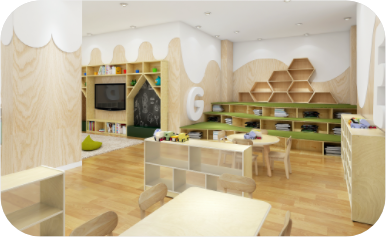
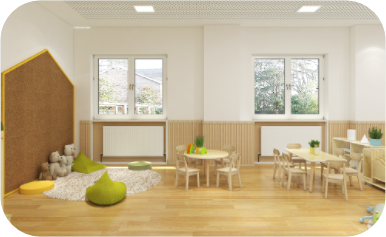
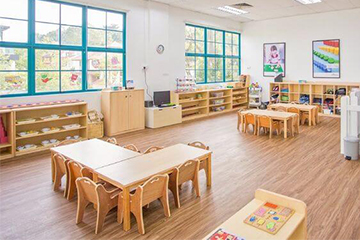



Classroom Design For Preschool
Preschool is particularly important for children’s learning and growth. Scientific design can create a safe, warm, and comfortable learning space for children. In addition, the classroom design preschool can make every space full of educational significance. The configuration of functional classrooms, wall decoration, and the placement of facilities add icing on the cake and bring beauty to the organization, and it is also full of positive energy.
First of all, the design preschool classroom should not be too boring. Under normal circumstances, the space of the child care center is limited, and the focus is on improving the children’s performance. Therefore, the space occupied by the classroom is relatively large. Therefore, the children’s activity space is mostly in the classroom. In this case, child training institutions should pay more attention to preschool classroom designs and environmental creation, and create a warm and comfortable learning environment for everyone. To a certain extent, it is also publicity for child care centers, which is conducive to the future development of child care centers.
Secondly, the design of preschool classrooms should be integrated into one’s own culture. The classroom space needs to be planned reasonably, such as scientifically placed shelves and bookshelves, which will not hinder the children from going to class, but can also bring more humanistic care to the children. The brand culture, humanistic culture, and management culture of the kindergarten center can all be reflected in the design of the classroom, which invisibly promotes the teaching philosophy of the institution.
Preschool Design Layout
The planning of the preschool classroom is divided into 5 areas: language area, science area, construction area, art area, and role area. There are three main principles of regional division: the principle of combining the whole and the part, the principle of balancing openness and enclosure, and the principle of complementing indoors and outdoors.
1: Language Area
The language area provides children with a rich language education environment, taking listening, speaking, reading, and writing as activity cues to comprehensively promote the development of children’s oral and written language. The language area provides tables, chairs, or floor mats to give children a quiet and warm reading environment.
2: Science Area
The science area should create a relaxed and comfortable atmosphere for scientific inquiry for young children, provide scientific observation, measurement, and classification activities, and support young children to use tools for exploration and scientific experiments. The science area needs to be set up in a location with good daylight, close to the water source, relatively quiet, and spacious.
3: Construction Area
In the construction area, children can explore the relationship between number and quantity by consciously stacking, inserting, arranging, and combining construction materials, and improve spatial awareness and geometric concept knowledge. The construction area needs to create an independent space with floor mats to reduce the noise of building blocks landing. The size of the building block storage cabinet should be different in length to facilitate storage and organization.
4: Art Area
According to the characteristics of various art forms, the art area should provide children with operating materials such as paints, brushes, various image qualities, and clay sculpture materials, and encourage them to paint, create by hand, and appreciate works. The artwork area should be set close to the water source, requiring an operable tabletop and a cabinet for storing materials and tools.
5:Role Area
The role area is where children use imitation and imagination to reflect real life by playing various roles. The role area can be close to the construction area, providing a combined toy cabinet and a small number of tables and chairs.
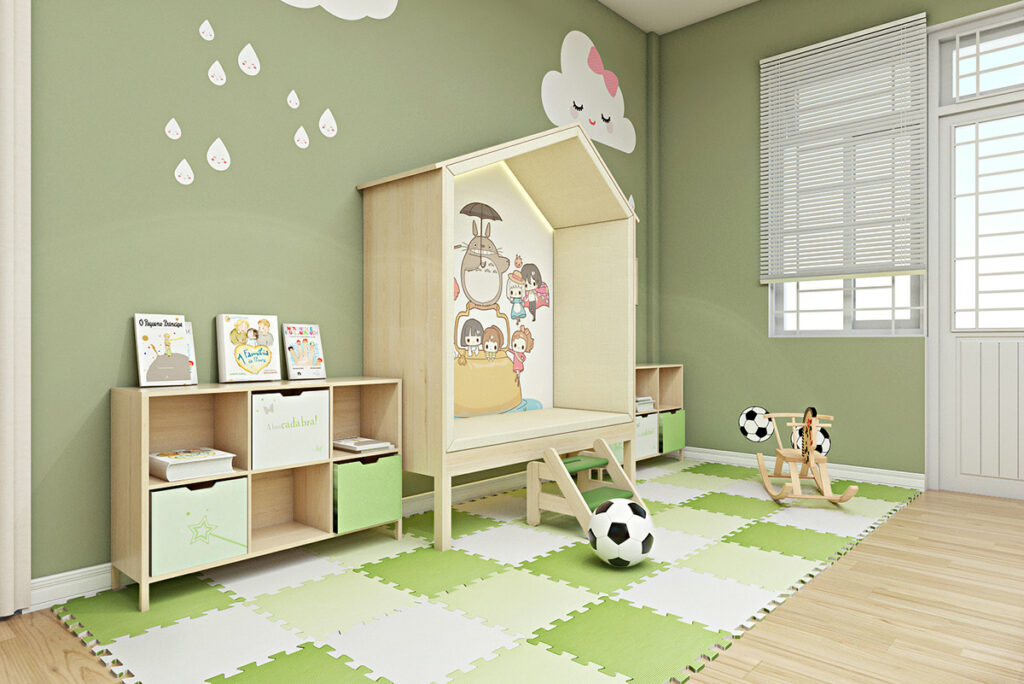

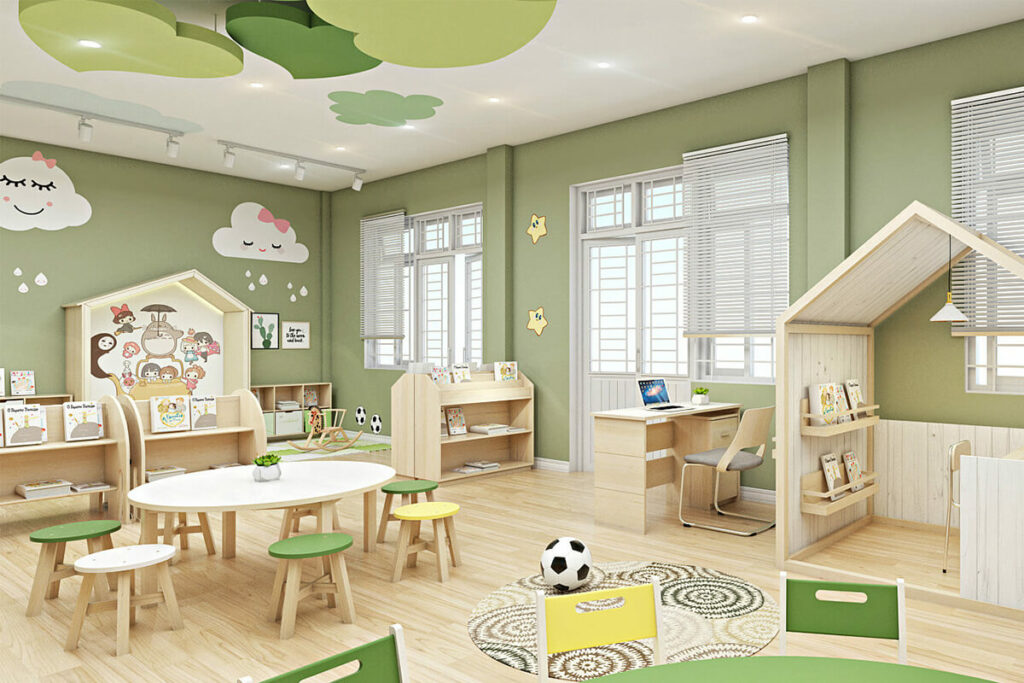
Preschool Furniture
Designing a preschool classroom can be a daunting task. It requires careful consideration of the needs of young children and how to create an environment that is both stimulating and safe. The design should also account for the different activities that children engage in, from learning to playing and provide spaces for them to do each activity. From preschool furniture to play centers and activity spaces, there are many preschool interior design ideas that can be used to create an inviting classroom environment for young children.
Preschool Design
how to design a preschool classroom
Preschool design refers to the layout, furnishings, facilities, and equipment in a preschool environment suited for young children aged 3 to 5 years old. The design of a preschool learning environment can greatly impact a child’s development. Discover the importance of thoughtful preschool layout ideas in this article.
The impact of design on child development
Preschool design concept can have a significant impact on a child’s development. A well-designed space can promote exploration, creativity, and social interaction, while a poorly designed space can hinder these important aspects of learning. For example, a cluttered and disorganized classroom can be overwhelming for young children, while a bright and colorful space with clearly defined areas for different activities can be inviting and engaging. By considering the needs and abilities of young children, designers can create learning environments that support their growth and development.
Creating a safe and stimulating environment
When preschool classroom interior design learning environments, safety should always be a top priority. This includes ensuring that furniture and equipment are age-appropriate and properly secured and that there are no hazards such as sharp edges or loose cords. At the same time, the environment should also be stimulating and engaging, with plenty of opportunities for exploration and discovery. This can be achieved through the use of bright colors, interesting textures, and a variety of materials and tools for children to use. By creating a safe and stimulating environment, designers can help young children develop important skills and abilities that will serve them well throughout their lives.
Preschool Set Up
Modern Preschool Design
Principles to be followed in preschool classrooms set up
1: Simple. The classroom is planned according to the above four partitions. The preschool classroom design layout should not be too complicated to confuse children.
2: Isolation. Small class children like to watch and play alone, the classroom should provide such a zone so that children do not have to play with other children.
3: Soft. Young children will be tired outside the home for a long time. So they need sofas, carpets, fabric wall decorations, and plush toys to give them rest.
4: Feelings. Photos, pictures, sound-producing toys, scented plasticine, objects of different materials, and other facilities and toys should provide children with various feelings. But be careful not to overload your child’s feelings.
5: Stimulus. There should be many open materials in the classroom, such as plastic boxes, bottles, containers for pouring water, building blocks of different sizes, crayons, chalk, tearable paper, paste, paints, etc. The number of such items must be strictly controlled, too much will cause confusion and disputes.
6: Stable. The turnover of toys should be slow and don’t replace too many things at once.
7: Safety. Large toys must be safe and sturdy, and items must be too big to be swallowed. Indoors should be checked every day, and children’s behavior should be closely monitored.



